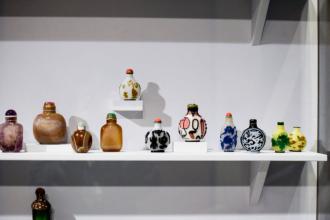For decades, comedians could always get a quick, cheap laugh talking about Berkeley and mind-altering substances.
Now, it’s the scholars who are framing the conversation.
The newest exhibition at UC Berkeley’s Phoebe A. Hearst Museum of Anthropology is “Pleasure, Poison, Prescription, Prayer: The Worlds of Mind-Altering Substances”. The exhibit explores not only the drugs you would expect— cannabis, opium, coca, peyote and even alcohol — but opens up new areas of discussion.
Is sugar a mind-altering substance? Is coffee? How about tobacco?
In a word, yes.
It’s all part of the Hearst Museum’s plan to challenge assumptions about mind-altering substances and the ways in which they have been used and viewed in different times and places.
“We found that 10 substances were well-represented in our collection,” says Adam Nilsen, the Hearst Museum’s head of education, who oversaw the exhibition’s curation. “We had long discussions about which objects told the richest stories about the substances’ complex meanings and worldwide migrations.”
The 10 substances are sugar, caffeine, tobacco, alcohol, cannabis, areca nut, opium, kava, coca and peyote. Others, including mushrooms and ayahuasca, didn’t make the cut because there weren’t items in the museum’s collection that adequately told their stories.
Listen to neurobiologist David Presti discuss the ritual use of psychoactive plants.
“Our goal in all of our exhibits is to encourage visitors to question things that may, at first glance, seem straightforward,” Nilsen says. “For instance, many people don’t know how and why tobacco made its way from the Americas to the entire world, or that beer was a sacred drink in ancient Egypt.”
Nilsen points out that almost the entirety of human experience has seen an exploration of plant-based substances that had the ability to change perceptions and alter minds. Sometimes, the item in question was ceremonial in nature, while others were used to improve health and still others were purely used for pleasure.
Sometimes, superstition was involved.
One of Nilsen’s favorite pieces in the exhibition, which has been compiled from the 3.8 million objects in the Hearst Museum’s collection, is a red-and-black terra cotta wine cup.
“If you were an ancient Greek getting tipsy at a symposium, you would want to protect yourself in a moment of drunken misjudgment from anyone casting you the evil eye,” Nilsen says. “A couple of these cups have big eyes painted on them. You could drink your wine and face those eyes outward to deflect the evil eye.”
Katie Fleming, the Hearst Museum’s gallery manager and education coordinator, is drawn to artifacts from a closer place and time.
“We have a number of opium pipes that were purchased in San Francisco’s Chinatown,” Fleming says. One is covered with speckled green shark skin. “They are beautiful on their own,” she says, “and we can learn a lot from studying how they traveled from China to San Francisco, where opium dens were for many years seen both as tourist attractions and as the epitome of moral weakness. “
“In a bigger sense, we can almost see history repeating itself with the modern day opioid crisis, where we see people subjected to stereotyping and misunderstandings, just as opium smokers were 100 years ago,” says Fleming. “This exhibit weaves together many different stories like these and invites visitors to share their perspectives.”
And then, there is sugar. Depending on your time, place and level of hunger, it could well be mind-altering. It certainly is for trick-or-treaters on Oct. 31.
“We are challenging the definition of what is mind-altering,” Nilsen admits. “Telling this story is a collection of elaborately-frosted Croatian cookies from the 1960s.”
Cookies? But of course. The examples being put forward as part of this exhibition are called licitars, colorfully decorated cookies made of sweet honey dough that are a Croatian cultural symbol. They are often used as ornamental gifts at weddings and on St. Valentine’s Day, and the Croatian capital city of Zagreb is awash with them during the Christmas season.
“Since many scholars today consider sugar to be a mind-altering substance,” Nilsen says, “what keeps us from calling these cookies drugs?”
